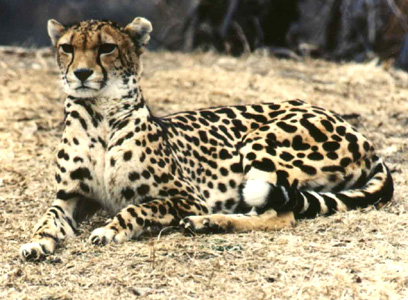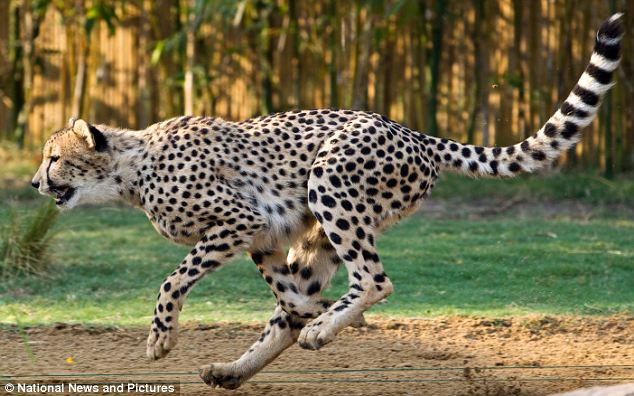spotless cheetah sighted in Kenya
A rare spotless cheetah, or “golden cheetah”, has been spotted in the wild, garnering significant attention and curiosity. This intriguing cheetah was sighted in Kenya, around the Nairobi-Amboseli area, and captured in photographs by wildlife artist Guy Combes. The unique appearance of this animal is a result of a recessive gene which dilutes the spots, making it fade into a golden hue. Encounters with this type of cheetah are extremely rare, making it a highly sought-after sighting for wildlife enthusiasts and researchers alike.
Cheetahs are known for their exceptional speed, being the fastest land mammals on the planet. They can reach speeds of up to 115 km/hour in captivity and 93 km/hour in the wild. However, they can only maintain these speeds for short distances. With their incredible speed and agility, cheetahs are formidable hunters, preying mainly on antelopes, zebras, and wildebeest. Cheetah populations face numerous challenges, such as habitat loss, poaching, and competition with other predators like lions and hyenas, making their conservation efforts crucial to their survival.
Key Takeaways
- A rare spotless cheetah, referred to as the “golden cheetah,” has been sighted in Kenya
- Cheetahs are the fastest land mammals, reaching speeds of up to 115 km/hour
- Conservation efforts are vital to protecting these rare and beautiful animals from threats such as habitat loss and poaching
Spotless Cheetah AKA Golden Cheetah Sighted in Kenya
In a rare event, a spotless cheetah was observed in the wild by British wildlife photographer Guy Combes. After hearing about potential sightings, he searched extensively in the Kenyan plains. Eventually, Combes was able to get within fifty yards of the extraordinary adult golden cheetah accompanied by its spotted mother. The last recorded sighting of a spotless cheetah was back in 1921.
After searching over 100,000 acres without borders, Combes feared he would not be able to find the magnificent cat that only a hand full of people will ever have the honor of seeing. Combes discovered the spotless cheetah at the Athi Kapiti Conservancy in Kenya.
This unique cheetah, found at Athi Kapiti Conservancy in Kenya, has a genetic mutation that could actually offer an advantage in the wild. Its appearance might easily be mistaken for a young lion at first glance.
The genetic mutation is thought to actually give this cheetah an advantage in the wild as this cat could easily be mistaken for a lion. As you can see in the photo above, at first glance you might assume you were looking at a young lion.
The wonderful photographs taken by Guy Combes give us the chance to see this incredibly rare amazing cat and it is quite thrilling even if in the form of a photograph. Of course, I never get tired of looking at any cat big or small.
Combes’ exceptional photographs of the rare spotless cheetah give us an extraordinary opportunity to witness this beautiful creature, contributing to our appreciation and understanding of the natural variations found in wildlife.
The King Cheetah of South Africa and Zimbabwe

Scientists theorize that the recessive gene that caused the lack of spots on this golden cheetah is similar to the phenomenon that causes the dappled markings of the “King” cheetah of South Africa and Zimbabwe. Unusual coat patterns such as this are natural variations that occur due to spontaneous genetic changes in genes.
Unusual fur patterns, such as this one, are considered natural variations resulting from spontaneous genetic changes in the animal’s genes.
King Cheetahs are distinguished by their rare fur pattern mutation, which requires a recessive gene inherited from both parents for the dappled pattern to appear. It is believed that the same genetic phenomenon may be responsible for the lack of spots seen on the recently sighted spotless cheetah in Kenya.
The Conservation Status of Cheetahs
The conservation status of the cheetah is officially classified as vulnerable with an estimated 12,400 remaining in the wild in twenty five African countries.
Namibia has the largest population of cheetahs with approximately 2,500 in the wild and wildlife officials believe there are only 50 of the Asiatic cheetahs remaining in Iran.
Frequently Asked Questions
What could lead to a cheetah not having spots?
A cheetah may have an absence of spots due to a rare recessive gene, resulting in a diluted spot pattern or a completely spotless appearance.
Have spotless cheetahs been documented in the past?
Yes, spotless cheetahs have been documented before, with historical accounts dating back to the 17th century, and the last recorded sighting was in 1921.
What is the current cheetah population in Kenya?
Population: The current cheetah population in Kenya is estimated at below 1300. However, it is important to note that cheetah sightings in Kenya are rare.
Is there a genetic mutation associated with the spotless cheetah?
Yes, the spotless appearance of the cheetah is believed to be associated with a rare recessive gene that dilutes its usual spotted pattern.
How do these variations impact the survival and adaptation of cheetahs?
Cheetah variations, such as the absence of spots, could impact their survival and adaptation by affecting their ability to camouflage and blend with their natural environment.
In which Kenyan reserves or parks are cheetahs most likely to be seen?
Some parks and reserves in Kenya where cheetah sightings may occur include Nairobi National Park and the Nairobi-Amboseli area. However, it should be noted that cheetah sightings are still considered rare events in these locations.



When I look at the top photo it reminds me of America’s cougars. But, the photo from behind does not. Amazingly beautiful!
Such a beautiful cat!!! Freckled cheetah — what a wonderful find!!!
They are all beautiful. Spots, dappled spots or just freckles. I would love to see any of them in the wild. Great article and pictures, Gracey. Thanks for sharing it with us.
I think all cats are beautiful too. I am going to look at the “Strawberry” leopard now.
I saw the strawberry one on the news a week or so ago. It is beautiful. I am sure that you will love it also 🙂
Thank mew for sharing this Gracey- he is beautiful. Mew are so CATabulous for advocating for our big cousins, they are amazing. What does Lazy Leopard think of this unique cousin of his? He must like to live with mew instead of in Africa since he’s lazy! MEWHAHA! Purrs to mew and Mercy. <3<3<3
Lazy Leopard is quite pleased to be living here with us. He is a little slower than his wild cousins. I will give Mercy a nose tap for you. xoxoxo
awwww he is so pretty, even without his spots 🙂 Thank you for sharing this rare find! xoxox
He is quite handsome even without his spots, isn’t he? Thank you for stopping by to read about these beautiful cheetahs.
They are amazing!
Thank you for sharing these beautiful pictures.
Thank you Sue for stopping by to visit and look at our big cat cousin’s photos.
Awesome! Thanks for sharing, Gracey! Did you read about the “strawberry” leopard that was also recently spotted? BIG CATS RULE!
I did see the information about the “Strawberry” leopard. Isn’t that also interesting?
That is way cool that he saw it and got pics!
It is amazing isn’t it Rumpy? And we are super lucky to be able to see the photographs.